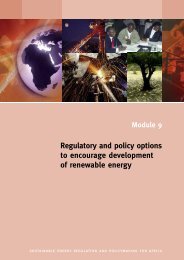Increasing access to energy services in rural areas - REEEP ...
Increasing access to energy services in rural areas - REEEP ...
Increasing access to energy services in rural areas - REEEP ...
Create successful ePaper yourself
Turn your PDF publications into a flip-book with our unique Google optimized e-Paper software.
MODULE 10: INCREASING ACCESS TO ENERGY SERVICES IN RURAL AREAS<br />
page 10.21<br />
Increased <strong>access</strong> <strong>to</strong> cash becomes crucial because improved <strong>energy</strong> <strong>services</strong> at the<br />
household level frequently necessitate switch<strong>in</strong>g <strong>to</strong> an <strong>energy</strong> technology that costs<br />
money from one that does not. Even where improvement <strong>in</strong> light<strong>in</strong>g results <strong>in</strong> cash<br />
sav<strong>in</strong>gs because the new source replaces more costly but less effective supplies<br />
(such as batteries and candles), there is frequently a net <strong>in</strong>crease <strong>in</strong> money expenditures<br />
because people make more use of the improved <strong>energy</strong> <strong>services</strong>.<br />
This means that attempts <strong>to</strong> reduce <strong>energy</strong> poverty (particularly us<strong>in</strong>g electricity<br />
supply technologies) face a particularly difficult issue <strong>in</strong> terms of the stated preferences<br />
of <strong>in</strong>tended beneficiaries. When <strong>rural</strong> people express their needs for<br />
improved <strong>energy</strong> <strong>services</strong> they often give high priority <strong>to</strong> light<strong>in</strong>g, a perfectly<br />
understandable position for those forced <strong>to</strong> live much of their lives <strong>in</strong> the semidarkness<br />
provided by candles or kerosene. But the most f<strong>in</strong>ancially susta<strong>in</strong>able<br />
decentralized electricity supply options are likely <strong>to</strong> be those which provide power<br />
<strong>to</strong> productive enterprises that can sell their products/<strong>services</strong> profitably. 36<br />
Figure I.<br />
The vicious circle of <strong>energy</strong> poverty<br />
1.<br />
No <strong>energy</strong> <strong>to</strong> run mach<strong>in</strong>es<br />
results <strong>in</strong> low productivity, poor<br />
quality and range of output.<br />
The issue is deepened by “time<br />
poverty”, mean<strong>in</strong>g women’s<br />
labour time cannot be released<br />
for economic activity.<br />
3.<br />
No money <strong>to</strong> buy improved<br />
<strong>energy</strong> supplies or <strong>energy</strong><br />
conversion equipment.<br />
vicious<br />
circle<br />
2.<br />
Low productivity, low<br />
surplus, little cash.<br />
36<br />
Generally village wealth will not <strong>in</strong>crease unless goods and <strong>services</strong> can be sold outside the village,<br />
this implies that roads and transport are likely <strong>to</strong> be necessary “complementary <strong>in</strong>puts”.










